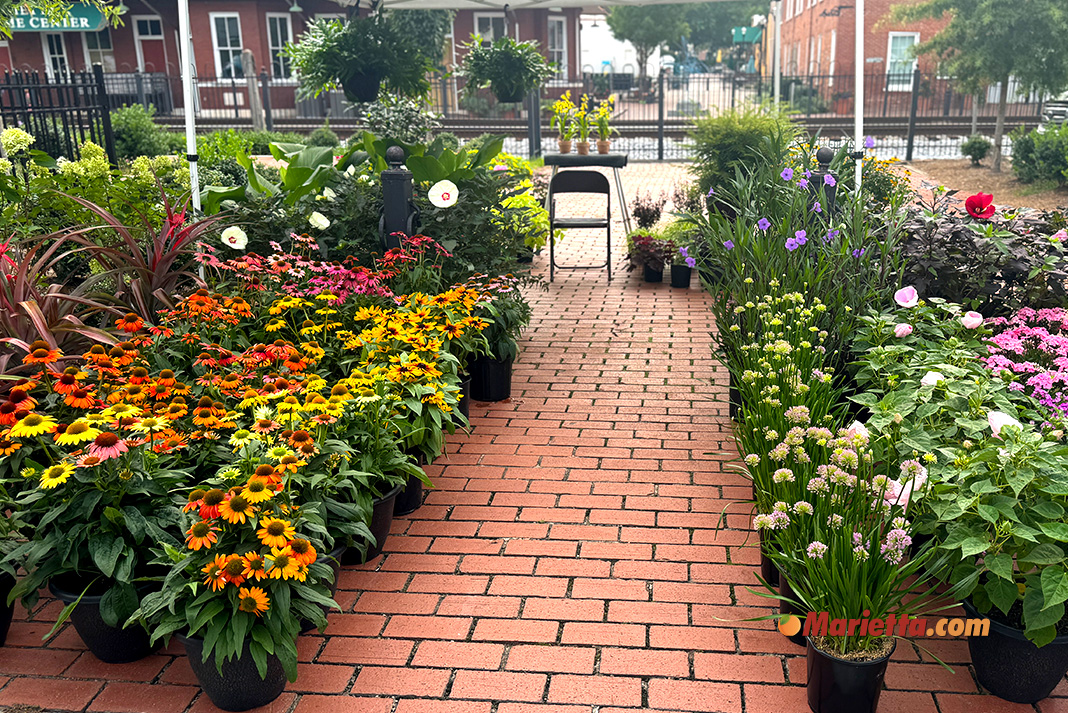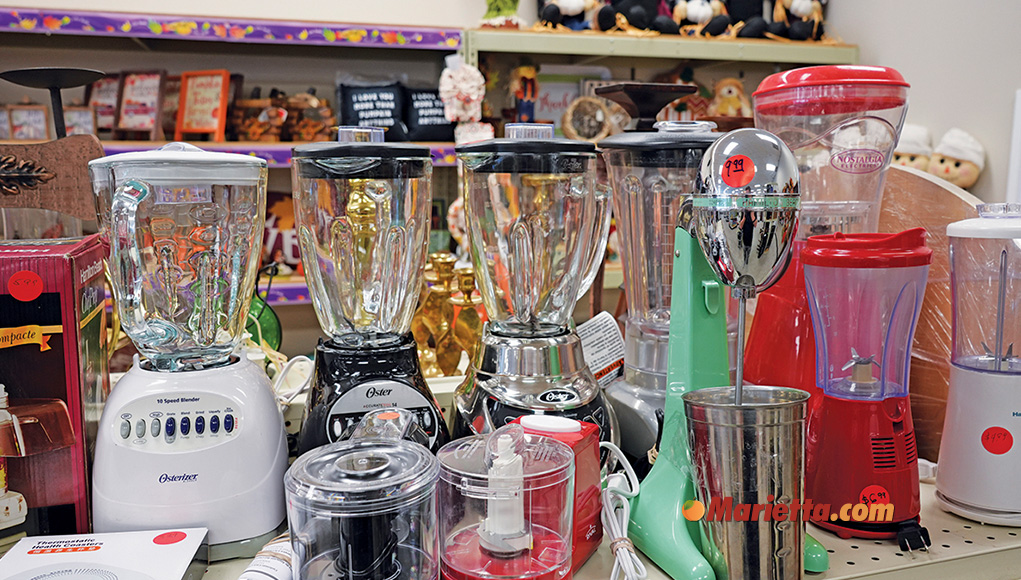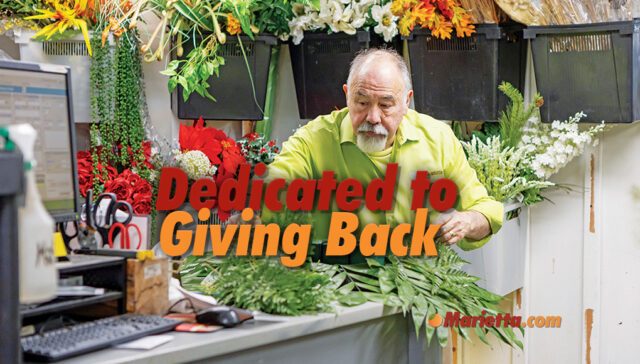Mike Whittle is a business owner dedicated to giving back.
K. Mike Whittle Designs Inc. — a family-owned business and staple in the Cobb County area — is well known for the finest in floral arrangements, gifts, and friendly, prompt service. Over the years, owner Mike Whittle also has developed a reputation as one of the community’s most giving, charitable business owners.
Mike Whittle’s journey into the floral industry began when he was only 13 years old, earning money selling soft drink bottles, cutting lawns and raking leaves, but he was eager to find ways to earn more.
Around that time, Whittle noticed cattails growing in a pond near his home in Smyrna. He ventured into that pond, cut the plants, and took them to Jonquil Florist hoping the owner would purchase them. “She asked me if I was interested in flowers, I told her that I had always loved flowers,” he recalls. “Then, she asked me if I could tie a bow, and I told her I didn’t think I ever had, but I thought I could, if she’d show me. She tied a corsage bow, gave me the ribbon, and told me to see what I could do.”
The florist was shocked when Whittle was able to tie the bow just as she had. She asked if he would like to help her in the flower shop over Mother’s Day weekend, and he agreed. He ended up tying more than 100 bows for orchid corsages, and Whittle continued to work in Ms. Betty’s shop, learning the trade and nurturing his gifts.
53 years later, Whittle is still in the industry, honing his skills, and making a difference in the lives of others. In the beginning, Mike worked with several area florists, including Petersens in Marietta before finally settling at a shop in Carrollton, Georgia with some dear friends. What Mike didn’t plan for was the reactions of others to his tasteful, opulent designs and charismatic personality. In a series of happenstances, Mike was approached and encouraged to open his own shop. After some discussions with friends in the funeral home industry and other area businessmen including Greg Litchfield, the wheels were set in motion and everything moved quickly. Following a trip to the bank and, hours later, a signed lease, Mike was prepared for late night renovations. After telling his wife, Vickie, and with her and others’ help and support, the opening of K. Mike Whittle Designs in the old Clark Library building, just off the square in Marietta was soon to be a reality.
When the time came for Whittle to tell the owners of The Flower Cart in Carrollton, Carolyn and Donald Threadgill, about his new venture, they were in full support as well. The 12 years spent working at their shop most certainly prepared him for the significant next step. They knew as well as Mike that a major benefit to owning his new shop would be working in closer proximity to his two grandchildren, so he never looked back.
Whittle opened the shop in October 2009, right in the middle of a recession, with a Christmas Open House. The rest is history, and “blessed” is the word he uses to describe his life today. “We have the best clientele in Cobb County and the surrounding area,” he says.
Located at 156 Church Street in Marietta, the shop also serves Kennesaw, Acworth, Powder Springs, Smyrna and Atlanta, but Whittle’s is equipped to send floral designs anywhere in the United States.
All in the details
K. Mike Whittle Designs offers full-service floral design and specialty services ranging from tropicals, plants, and a variety of fresh floral arrangements to silk and dried floral arrangements. The shop employs nine people full-time, with others on standby for seasonal work.
Whittle says the impeccable service he and his team can offer starts with a laser-focused attention to detail. He employs award-winning designers with years of experience spanning all aspects of the floral industry. Whittle and his team keep their ideas and floral offerings fresh and modern, attending shows and seminars to keep abreast of new products and trends.
“We are very detail-oriented to ensure our customers are taken care of in every way,” K Mike says. “We offer designs using unique and different flower varieties, and we continue our education through the Society of American Florists, the American Institute of Floral Design, Georgia Florist Wholesalers, Georgia State Florist Association, and the Florida State Florists’ Association.”
K. Mike Whittle Designs has a steadfast following of loyal customers who are happy to sing his praises any time they can. “Mike is so talented, and the quality of his work is unsurpassed,” says Wanda Callahan with Cobb’s 10 Women of Hope organization. “Not only does he provide exquisite floral designs, but his devotion to our community is also second to none.”
The gift of giving
Cobb County is full of successful businesses of all sizes, serving all the needs imaginable of consumers. The difference, however, between a successful business owner and a business owner dedicated to giving back to the community is what makes Mike Whittle such a contribution to the Cobb County community.
Whittle says the main way he and his staff give back to the community is through the provision of flowers for charitable events. Rather than focusing heavily on advertising, Whittle lets his charitable contributions of gorgeous flowers serve as the message about him and his business. “We have always been there when people needed us. We choose to provide flowers when they are needed for the fundraisers in our area,” he says. “We are very proud to be able to support so many of our clients for these events, year after year, because they have been so good to us. One of the great things about our community is that we support each other even in the bad times, such as during the COVID-19 pandemic.”
Whittle supports schools, hospices, churches, women’s groups, the Fraternal Order of Police, Children’s Healthcare of Atlanta (CHOA), and garden clubs, to name a few. “We love to give to Children’s Healthcare of Atlanta,” he says. “We do something for them every week, and we are there so often that my grandson calls it ‘his hospital.’ Pam Yonker and her team are absolutely wonderful to work with.”
As it turns out, for Yonker, community development officer for CHOA, the feeling is mutual. “I’m not sure there is anyone who can outdo Mike Whittle in giving back to the community,” Yonker says. “Whether it’s giving out flowers to people ‘just because’ or providing a whimsical arrangement every week to brighten the faces of the patients, parents, and the staff at Children’s Healthcare of Atlanta’s Town Center Urgent Care, Mike’s positive attitude and caring spirit are pervasive in our community. We are incredibly grateful for Mike and how he uses his God-given talents to minister to so many people!”
K. Mike Whittle Designs has been involved in numerous galas, both large and small. One of Whittle’s favorite events is a fundraiser for the Center for Family Resources, a Cobb County organization that works to serve families and individuals who are either homeless or in danger of becoming homeless. “It’s always beautiful and special,” Whittle says, “They give me a theme and let me be creative, which works best. We collaborate among our entire floral team and the event always turns out beautifully.”
Whittle says his mission is to be creative and satisfy each customer with plenty of customer service. When a client calls him with a budget, he will do the best that he can, no matter the size of the budget. The pressure to do more and spend more is not there, and customers appreciate that.
The list of Cobb community leaders who rave about K. Mike Whittle Designs is long and impressive. One would be hard-pressed to find anyone who isn’t a fan of Whittle and his amazing team. “Mike’s floral creations truly reflect his unique personality, which is often whimsical and surprising, and always designed with meticulous care,” says Patti Schoettler, an independent agent for AFLAC, known servant leader, and 2022 Kennesaw Citizen of the Year. “Mike has a heart for bringing joy to others through the gift of flowers, and countless organizations in our community can attest to his generosity.
Meant to be
Whittle makes no bones about the required mix of talent and passion needed to run his business, and how that recipe has been key to his success. “You have to have a God-given ability to do it, and do it right,” he says. “It’s also knowing the differences in flowers and how they work for different designs. I’ve done a lot of training through the years, and it enhances your creativity.”
And when it comes to a natural ability, well, that matters as well. “Being a florist gets in your blood, and you can’t get out of it. I have had an appreciation of flowers since Day 1! And, God has Blessed us from the start to what we have become today.”

















































